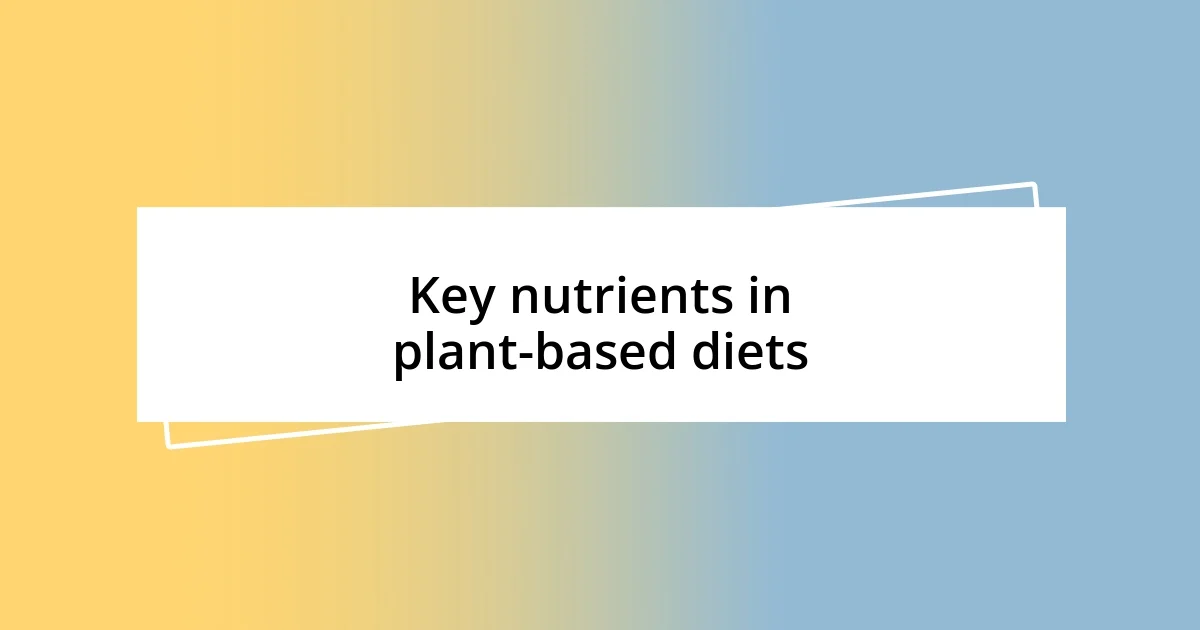Key takeaways:
- Switching to a plant-based diet can significantly improve energy levels, digestion, and overall vitality, fostering a deeper connection with food.
- Key nutrients to focus on in a plant-based diet include protein, iron, vitamin B12, omega-3 fatty acids, calcium, and zinc to ensure balanced nutrition.
- Effective meal planning strategies like weekly prep, creating versatile grocery lists, and batch cooking can enhance convenience and enjoyment in a plant-based lifestyle.

Understanding plant-based eating benefits
When I first made the switch to plant-based eating, my energy levels skyrocketed. I found myself feeling lighter and more agile, a sensation I hadn’t experienced in years. Isn’t it fascinating how the right foods can transform our daily vitality?
One striking benefit that caught me off guard was how my digestion improved. At first, I thought it was just a phase, but over time, I noticed fewer bloating episodes and an overall sense of well-being. Have you ever considered how much your diet impacts not just your physical health, but your mental clarity, too?
As I explored various recipes and ingredients, I became more creative in the kitchen. This newfound culinary adventure isn’t just about nourishment; it has fostered a deeper connection with the food I consume. Isn’t it wonderful when our meals don’t just fuel our bodies but also ignite our passion for cooking and experimenting?

Key nutrients in plant-based diets
When delving into plant-based diets, I quickly realized the importance of certain key nutrients. Specifically, I found that I had to pay close attention to protein, iron, and vitamin B12, which can sometimes be overlooked in plant-rich eating. Remembering my first few months, I often felt fatigued until I started incorporating various sources of these nutrients into my meals. It was a transformative experience that helped me understand how every nutrient plays a vital role in supporting overall health.
Here are some important nutrients to consider in a plant-based diet:
- Protein: Sources like lentils, chickpeas, and quinoa offer great protein content.
- Iron: Spinach, beans, and fortified cereals are essential for preventing deficiency.
- Vitamin B12: As this is primarily found in animal products, supplements or fortified foods are crucial.
- Omega-3 Fatty Acids: Flaxseeds and walnuts help maintain heart health.
- Calcium: Don’t forget about almond milk, tofu, and broccoli as excellent sources.
- Zinc: Incorporating nuts, seeds, and mushrooms can enhance your immune function.
Looking back, I remember the initial struggles to get enough of these nutrients, often flipping through plant-based cookbooks late into the night. It has been a journey, but knowing the right nutrients to focus on made my transition smoother and gave me a sense of empowerment over my health.

Practical tips for meal planning
When it comes to meal planning for a plant-based diet, I swear by the power of preparation. One thing that transformed my culinary routine was dedicating a few hours each weekend to chop veggies, cook grains, and even portion out meals. It not only saves time during the week but brings a wonderful sense of accomplishment. Have you ever felt how satisfying it is to open your fridge and see a rainbow of prepared meals just waiting for you?
Another tip I found invaluable is creating a versatile grocery list. I tailor mine around staple ingredients that can be used in multiple recipes, which keeps my shopping straightforward and economical. For instance, when I stock up on quinoa, beans, and seasonal vegetables, I can whip up everything from salads to hearty stews. It’s incredible how these basics can lead to a variety of delicious meals!
Lastly, don’t underestimate the power of batch cooking. Early in my plant-based journey, I often found myself caught off guard by my schedule. After a few hectic days, I started making larger portions, which I could freeze for later. Now, those frozen meals are my lifesaver on busy evenings. By implementing these strategies, meal planning not only became manageable but also incredibly enjoyable.
| Meal Planning Tip | Description |
|---|---|
| Weekly Prep | Dedicate time on weekends to prepare ingredients and meals. |
| Versatile Grocery List | Stock staple items that work in various dishes for easy meal prep. |
| Batch Cooking | Cook large proportions and freeze for quick meals on busy days. |

Delicious plant-based recipe ideas
One of my absolute favorite plant-based recipes is a hearty lentil and sweet potato stew. I love how the sweet, earthy flavors blend together, creating a comforting dish that warms the soul, especially on chilly evenings. The first time I made it, I was surprised at how filling and satisfying it was—I didn’t miss meat at all! I often toss in spinach at the end for some extra nutrients, and every bite feels like a hug in a bowl.
Another go-to recipe that I can’t recommend enough is a simple chickpea salad. I remember the thrill of discovering how versatile chickpeas could be. Just mix them with diced cucumbers, tomatoes, parsley, and a drizzle of lemon tahini dressing, and you’ve got a refreshing dish that’s perfect for lunch or a light dinner. It’s quick to prepare, and honestly, the vibrant colors and textures make me excited to eat healthy—who wouldn’t want to dive into something that looks so inviting?
Lastly, I can’t mention delicious plant-based recipes without highlighting the magic of smoothies. My morning routine transformed once I started blending together spinach, banana, and almond milk to kickstart my day. It’s like a burst of energy in a glass! Whenever I help friends make their first smoothie, I love seeing their surprise at how creamy and delicious it can be. Isn’t it amazing how something so simple can be both nourishing and enjoyable?

Overcoming challenges with plant-based eating
Transitioning to a plant-based diet can come with its fair share of challenges, but I’ve found that awareness and preparation make a significant difference. For instance, when I first started, I struggled with feeling deprived of my favorite foods. To combat this, I began experimenting with plant-based versions of familiar dishes, like vegan tacos filled with lentils and avocados. It was surprising to see that I didn’t miss the traditional ingredients as much as I thought I would. Have you ever felt that magic moment when a plant-based version exceeds your expectations?
Another challenge is social situations where food focuses heavily on meat-based options. I used to feel anxious about attending gatherings, thinking I’d be left out. But I’ve learned to bring my own dishes to share, turning those moments into opportunities to introduce friends to tasty plant-based options. I remember one barbecue where I brought a mouth-watering quinoa salad. Everyone ended up asking me for the recipe, which was such a gratifying experience! It’s amazing how sharing food can bridge gaps and spark curiosity.
Lastly, one of the most surprising hurdles for me was the lack of convenience in finding plant-based options while traveling. I often found myself staring at menu options that seemed to ignore my dietary choices altogether. To tackle this, I learned to research restaurants ahead of time and even carry snacks like nut bars and dried fruits. Once, I stumbled into a tiny cafe in a new city and found a hidden gem—a plant-based Buddha bowl that blew my mind! Being prepared not only kept my meals interesting but also made my food journey enjoyable. What’s one strategy you’ve found helpful in navigating plant-based eating during your travels?

Incorporating variety in your diet
Incorporating variety in your diet is one of the most exciting aspects of plant-based eating. I remember the first time I decided to explore different grains like quinoa, farro, and barley. It was a revelation! Each grain brought its unique flavor and texture to my meals, making dinner feel like a culinary adventure. Have you tried switching up your grains? It can completely transform the feel of a dish and keep your taste buds dancing.
I’ve also found that utilizing seasonal vegetables can add so much freshness and variety to my plates. For instance, during the summer, I go crazy for grilled zucchini and corn, while fall brings a warmth with roasted root veggies like carrots and beets. There’s something so satisfying about tailoring my meals around what’s in season; it’s like cooking with nature itself. Plus, it not only diversifies my diet but also supports local farmers. Have you ever tasted a freshly harvested vegetable? The difference is incredible!
Then there are my spice adventures—I can’t emphasize enough how much they elevate a dish. I love to explore different cuisines, like Indian curry or Middle Eastern falafel, which encourages me to use spices I wouldn’t typically reach for. I still recall the first time I made a coconut curry; the aromatic blend of turmeric, cumin, and coriander had my whole kitchen smelling divine! It made me rethink how insipid my meals had been before. Spices can add layers of flavor and inspire creativity in the kitchen. How do you bring zest to your meals?













